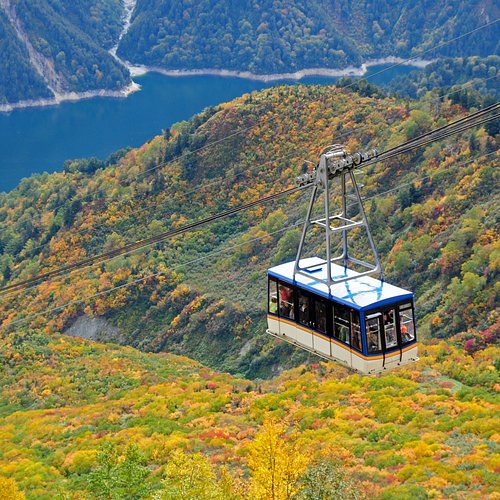Things to do in Tateyama-machi, Chubu: The Best Transportation
Discover the best top things to do in Tateyama-machi, Japan including Tateyama Ropeway, Tateyama Highland Bus, Kanden Tunnel Electric Bus, Kurobe Cable Car, Tateyama Tunnel Trolley Bus, Tateyama Cable Car.
Restaurants in Tateyama-machi
1. Tateyama Ropeway
Overall Ratings
4.5 based on 59 reviews
Tateyama Ropeway is running between Daikanbo station and Kurobeko station with 7 minutes. You can enjoy a large panoramic view on the usual ropeway which is no pillar between stations. Especially, the view from the ropeway is so amazing in autumn season(late Sep~ early Oct).
2. Tateyama Highland Bus
Overall Ratings
4.5 based on 33 reviews
Tateyama Highland Bus is running 23 km between Bijodaira station and Murodo station with 50 minutes. It is an environmentally friendly bus that controls exhaust emissions. During taking this bus, you can see a huge Tateyama Ceder and Shomyo Falls if the weather permits.
3. Kanden Tunnel Electric Bus
Overall Ratings
4.0 based on 154 reviews
Reviewed By PeterthePauper - Ulsan, South Korea
The Kanden Tunnel was originally constructed to provide access for the construction of the hydroelectric plant of Kurobe Dam. Opened in 1964 as a trolleybus line, the trolleybuses ceased to operate in 2018 when the vehicles were replaced with modern battery-electric buses which convey passengers on the 6.1km route from Ogizawa Station to Kurobe Dam Station in 16-mins. At peak, as many as 10 individual buses can run in a single convoy through the tunnel (10-buses being the maximum number that can be accommodated in the passing place, mid-tunnel). Similar to the Tateyama tunnel, the tunnel itself passes through an 80m long 'Fracture Zone' which took some 7-months to negotiate a mere 80m length, tunneling through unstable rock and torrential water; these days this stretch is illuminated by blue light. On the Rainbow Terrace at Kurobe Dam, there is an interesting (free) exhibition regarding the construction of the Kanden Tunnel and the Kurobe Dam, that's worth a visit. Interesting fact: In the mid-1990's the original fleet of trolleybuses were replaced with newer trolleybuses. 9 of the original fleet of trolleybuses were donated to Mexico City's "Servicio de Transport Electricos" (STE). Despite being shipped all the way across the Pacific to Mexico, the trolleybuses were never put into service by STE. As recently as 2012, at least one of the Japanese trolleybuses has been spotted in Mexico City in use as a public art installation. Fancy that!
4. Kurobe Cable Car
Overall Ratings
4.0 based on 60 reviews
Kurobe Cable Car is running between Kurobedaira station and Kurobeko(Kurobe Lake) station. It is the only cable car in Japan which runs in the underground throughout whole line. It moves on a steep slope of up to 31 degrees in 5 minutes.
Reviewed By PeterthePauper - Ulsan, South Korea
If descending out of the clouds to Kurobedaira on the Tateyama Ropewy wasn't exciting enough, yet another treat was in store in transferring to the funicular at the Kurobedaira interchange. The Kurobe Cable Car is the only completely underground cable car in Japan, which allows it to remain unaffected by snowfall. Although only 0.8km in length, you drop 373m in elevation in that distance, hence the slope is very steep with a maximum incline of about 30 deg. Ideally , get a position in the front of the car and watch the ascending car approaching, seemingly on a collision course, until the passing loop materialises out of the darkness. Not exactly scenic, but nevertheless quite exciting. When you arrive at the lower Station (Kurobeko), you exit back into the sunshine at top-of-dam-level at the Kurobe Dam.
5. Tateyama Tunnel Trolley Bus
Overall Ratings
4.0 based on 40 reviews
Tateyama Tunnel Trolley Bus is running between Murodo station to Daikanbo station with 10 minutes. Trolley bus moves with electric power throughout the tunnel directly under Mt.Oyama(3,003m) which is the main peak of Tateyama. It is only Alpine Route in Japan that Trolley bus runs.
Reviewed By PeterthePauper - Ulsan, South Korea
Originally opened for operation with normal diesel buses in 1971, the tunnel was re-equipped for trolleybus operation in 1996. There are 8 buses in total (numbered 8001 ~ 8008), and seem to generally run in close convoys of 3 buses in each direction. Although they look like a conventional bus, they are legally classified as a train because it runs on electricity drawn from an overhead power supply and can only run on roads equipped with such dedicated supply lines, rather than ordinary roads. As interesting as the buses are themselves, for me the fascination is in the actual tunnel; barely a bus width for its' entire 3.7km length, with a passing place halfway for the bus convoys to pass. There is a 134m elevation difference between Murodo (2,450m) and Daikanbo (2,316m), which has to be accommodated in its' length and near the passing place, the tunnel passes through a 'Fracture Zone' which marks a fault line in the area's geology. Fracture Zones are notoriously difficult to tunnel through and can result in flooding. This area is currently illuminated by blue lights.
6. Tateyama Cable Car
Overall Ratings
4.0 based on 27 reviews
Tateyama Cable Car is running between Tateyama station and Bijodaira station. It is a Cable Car with an unusual loading platform. Two vehicles operate on a slope with an elevation of 502 m and a slope of 24 degrees on average. From this Cable Car, you can see columnar jointing what rocks lie on top of each other like pillar!






